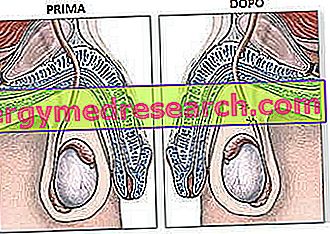Generality
Vasectomy is a method of permanent contraception (sterilization), reserved for male persons; to obtain this result, during the vasectomy the urologist doctor cuts the vas deferens, present at the level of the scrotum, and seals them. In this way, the spermatozoa produced by the testicles are prevented from joining the seminal fluid and forming the sperm.

Vasectomy can be performed for various reasons: it can be requested by people who no longer want to have children, or it can be a way, adopted by some countries, to control births.
There are two types of operative procedures: traditional vasectomy and scalpel-free vasectomy.
Like any surgical procedure, complications may arise, but these are very rare cases.
Short reference to the male genital system
The male genital apparatus is composed mainly of the following parts:
- Testicles . Contained in the scrotum, they are two in number and have the task of producing millions of spermatozoa, or male sex cells; they also produce male sex hormones ( testosterone ), fundamental in the development of primary and secondary sexual characteristics and in the control of the functions of the genital apparatus itself.

- Deferent scholars . They are the channels that unite the testicles, first, to the seminal vesicles and then to the prostate; through them sperm flow, which will join the seminal fluid to form the sperm.
- Urethra . It is a small canal, which runs throughout the penis, through which urine and seminal fluid (or sperm, if in the seminal fluid there are also spermatozoa) are expelled. The release of seminal fluid is called ejaculation. To check that urine and seminal fluid do not mix together, there is a sort of muscular valve.
- Penis . It is the male reproductive organ and the last part of the urinary tract. Thanks to its particular anatomical structure, it allows the passage of spermatozoa from man to woman.
What is vasectomy?
Vasectomy is a surgical contraception procedure, reserved for male people. In medical language, one speaks more correctly about deferentectomy ; in fact, through this intervention the two vas deferens are permanently cut and sealed. By interrupting these channels, the spermatozoa coming from the testicles are prevented from uniting and making fertile the seminal fluid produced by the prostate and emitted with ejaculation.
Compared to tubal ligation, which is the corresponding intervention in women, vasectomy is less dangerous and more effective.

Figure: vasectomy and main elements of the male genital apparatus.
PERMANENT OR NON-PERMANENT?
Vasectomy is considered a permanent method of contraception, although there is actually the possibility of reversing its effects with a specific operation.
For what reason?
Reversion intervention is complicated and often ineffective, even when no complications occur.
Therefore, before undergoing vasectomy, it is good to be aware of all the details of the operation, from the advantages to the disadvantages.
THE MYTHS TO DEAL WITH
Many men fear that vasectomy will reduce libido and sexual performance, or predispose to some serious illness (cancer and heart disease). However, these are just unfounded fears due to bad information.
The fears lacking any scientific validity, which we usually hear about, argue that the vasectomy:
- Influence sexual performance . Vasectomy does not reduce either libido or masculinity: in fact, hormone levels of testosterone, erection and ejaculation are completely normal. The only difference is that the seminal fluid does not contain spermatozoa, therefore it cannot be defined as sperm.
- Permanently damage the structures of the genital apparatus . It is very rare for vasectomy to cause permanent and irreparable damage to the penis, testicles or other parts of the male genital tract. As we will see later, the success rate of the operation is almost 100%
- Increase the risk of getting cancer . Especially in the past, someone believed that the vasectomy favored testicular or prostate cancer. There is no scientific evidence in favor of this thesis.
- Increase the risk of developing heart problems . The same applies as for prostate and testicular tumors: no scientific link has been demonstrated between these and vasectomy.
- You cause a strong and acute pain . The acute and very intense pain is really a very rare eventuality. In fact, pain is generally mild and vanishes in a few days. If it is prolonged for a longer period, it is still bearable.
Furthermore, some benefits that are erroneously attributed to vasectomy should also be dispelled. For example, someone believes that the operation protects against sexually transmitted diseases and AIDS, but this is not the case at all. In fact, the same protections and precautions are needed, adopted before the intervention and by any other person.
When you run
Vasectomy is a contraceptive method particularly indicated for those who, at some point in their lives, have decided not to have other children (or not to have any). The reasons may be the most diverse and depend on person to person, or from family to family.
In any case, it is a very practiced operation, as it is safe and has a probability of success of almost 100%: only one intervention every 2000, in fact, does not provide the desired results.
VASECTOMY AS A METHOD OF CHECKING THE BIRTHS
In some regions of the world, vasectomy is performed to check the number of births. Clearly, these are countries, such as China or India, where the birth rate is very high and there are problems of overpopulation.
Preparation
Those who have decided to undergo vasectomy must know what they are going through. Therefore, the urologist, before the intervention, will discuss and ask the patient several times (understood as he who is about to perform a surgical operation), if he is fully convinced of his decisions.
The nodal points of the discussion are:
- Remember the permanence of the effects, because the choice to undergo vasectomy could have been a rash choice, due to the news of another pregnancy of the own partner or to a bad information. In fact, there are those who believe that reversion intervention is a common and easy practice.
- Confront with the partner, even if it has already been done on other occasions. This person could agree, but, at the time of the operation, have second thoughts. Let it be clear, nothing prevents an individual from undergoing vasectomy, even if the partner disagrees: in fact, the decision is only up to the patient.
- Remember the other existing methods of contraception, even non-permanent ones. Indeed, there are alternative, sufficiently effective and non-permanent solutions.
- Remember that vasectomy is still a surgical procedure and that, as such, it can lead to complications.
PREOPERATIVE INSTRUCTIONS
Before performing the vasectomy, the doctor gives the patient several instructions, useful so that the surgery can be successful.
First of all, it prohibits the intake of aspirin and any other drug with a similar action (warfarin, heparin, etc.). Similar treatments should be stopped early, because the pharmacological effects last at least a week.
After that, it requires that the patient: shave the pubic area to be operated, so that the washing of the same is easier and the risk of infection is less; get some tight underpants (also called containment underpants ) or tight-fitting shorts, to block the movement of the scrotum and minimize swelling; be accompanied by a relative, because sitting down to drive could compress the operated area.
Procedure
Vasectomy is a fast and not particularly painful surgical operation, which is usually performed under local anesthesia . During the operation, the urologist takes steps to cut and block (the technical term of this maneuver is ligation) the vas deferens, in order to interrupt every pathway that leads sperm to union with seminal fluid.
Generally, the operation is of an outpatient type and no hospitalization is envisaged: discharge, in fact, takes place on the same day as the operation.
There are two procedural methods, one traditional, also called conventional vasectomy, and one in which no scalpel is used, known by the term Anglo - Saxon no-scalpel vasectomy or no-scalpel vasectomy .
ANESTHESIA
Anesthesia is, in most cases, local. Therefore, the areas to be operated, ie scrotum and testicles, are rendered insensitive to the patient.
Perceived pain is minimal and is more like a nuisance.
When is general anesthesia used?
If the patient, during preoperative analysis, has declared to be allergic to local anesthetics or tends to faint easily, he is sedated with general anesthesia .
During general anesthesia, anesthetic drugs are administered before and during the entire procedure, making the person completely unconscious.
The intravenous infusion of sedatives stops when the operation is finished. It is very important, as a preparatory measure for general anesthesia, to present a complete fast from the previous evening.
CONVENTIONAL (OR TRADITIONAL) VASECTOMY
Once local anesthesia has been practiced, the urologist performs two small incisions (approximately 1 cm), to the right and to the left of the scrotum.
These incisions represent the access ways to reach, with the scalpel, the vas deferens. Once the incision is made, part of the canals is removed and the so-called vas deferens or, alternatively, diathermy is removed.
Once the operation is concluded, the incisions are closed with resorbable sutures .
What does diathermy do?
Diathermy seals the vas deferens thanks to the use of a very small probe, crossed by a current and able to generate heat.
The advantage of diathermy is that bleeding (ie blood loss) is severely limited.
VASECTOMIA NO-SCALPEL (OR VASECTOMY WITHOUT SCALPEL)
During a scalpel-free vasectomy, the doctor first looks for the vas deferens under the scrotal skin and holds them in place with tweezers.
Then, thanks to a special instrument, it performs a small puncture in the center of the scrotum; this, once enlarged very gently, allows it to reach the vas deferens and to cut them (or seal them), in the same way as the conventional vasectomy.
Blood loss is minimal and no stitches are expected, as the wound heals on its own.
| Conventional vasectomy | No scalpel (or no-scalpel) vasectomy |
The pros:
The cons:
| The pros:
The cons:
|
DURATION OF THE INTERVENTION

Figure: without a scalpel vasectomy. From the site: //urologovalladolid.com
Both conventional and traditional vasectomies are two very fast procedures, which generally require 15 to 20 minutes, except for complications.
Post-operative phase
During the first hours and the first days after the operation, it is very likely that the patient suffers pain or slight pain in the operated area, and that he develops swelling and a hematoma.
Pain, swelling and hematoma are three normal manifestations, which must not alarm, unless they last for several days or, instead of shrinking, intensify.
It is also normal for blood to be emitted at the first ejaculation.
Important note : for at least the first 20 ejaculations, the seminal fluid still contains traces of spermatozoa. This is completely normal, as they are the remains of the last successful sperm production. Therefore, while waiting for the last spermatozoa present to be exhausted, it is advisable to use the classic methods of contraception (for example, a condom).
STITCHES
When applied, the stitches take about a week to fully reabsorb.
UNDERWEAR
Day and night, it is advisable to wear close-fitting (or containing) underpants, to keep the scrotum blocked and limit swelling.
Without them, the testicles are more mobile and their movement heightens the painful sensation.
HYGIENE
Hygiene is essential to prevent infections from developing.
Therefore, it is advisable to wash the operated area every day, being very careful not to stress the wound, to dry the whole area well, and to change the containment underpants daily.
RECOVERY OF WORK AND SPORTS ACTIVITIES
After the vasectomy, wait at least a couple of days before returning to work .
Exercise, on the other hand, should be resumed with much more caution: if it is not particularly heavy and dangerous for the operated area, it is necessary to wait at least a week (generally, when the stitches have been completely reabsorbed) ; if, on the contrary, it is contact sports or where the operated part is at risk, it is better to refrain from these activities for several weeks.
SEXUAL REPORTS
The resumption of sexual relations with one's partner must occur when the points are reabsorbed and when the pain in the operated area has disappeared or has become bearable; first, the practice is not recommended. Furthermore, it is good to remember what was said previously: for the first 20-30 ejaculations, the seminal fluid still contains some traces of spermatozoa, therefore alternative contraceptive methods should be used.
HOW to understand if VASECTOMY HAD SUCCESS?
In order to know if there are still traces of spermatozoa, it is necessary to subject a seminal sample to two microscopic checks (one serves as a counter-check).
In general, it is necessary to wait, before the analysis, from 20 to 30 ejaculations and / or about 8 weeks; before, in fact, it is useless to carry them out, as the spermatozoa would surely be present.
Only once the seminal fluid is free of spermatozoa, can substitution contraceptive methods be abandoned.
Special case : some men have little movable spermatozoa. In this case, their permanence, in the channels of the reproductive system, lasts much longer than 8 weeks and lasts for more than 20-30 ejaculations. What to do in these situations? Wait and be patient. Time after the first analysis, it is good to repeat them, to see how the situation has evolved.
FREQUENT QUESTIONS
Is it possible that the passage that leads the sperm to join with the seminal fluid spontaneously re-form?
Yes, but it is such a rare eventuality that it is considered almost impossible.
What are the signs of an ongoing infection?
Indications of an infection are: loss of blood from the operated area, fever at least 38 ° C, worsening of pain and swelling.
How long are the fitted underpants worn?
In general, it is sufficient to carry them for 48-72 hours, however each patient represents a special case.
How can the recovery and resorption of the hematoma be accelerated?
It may be useful to apply ice at intervals of time and never in direct contact with the operated area.
Risks of the transaction
Vasectomy is now a fairly safe technique. In fact, complications and side effects are a rare occurrence.
However, it is important to summarize the main risks, which can be encountered in the operation:
- Extended scrotal hematoma . A hematoma is due to the rupture of a fair number of blood vessels, located in a certain tissue. After vasectomy, the appearance of a hematoma at the level of the scrotum is quite normal. It is not normal, however, that this hematoma, instead of resolving within a few days, becomes more and more extended and accompanied by acute pain. In very serious cases, it is even necessary to intervene surgically a second time, to remove the blood clot formed after the vessels have broken.
- Wound infections . The scrotal area can become infected, especially if the wound is not kept clean.
- Ejaculations containing blood . Generally, the first ejaculation, after vasectomy, always contains blood. It is normal and you should not be alarmed. On the other hand, it is worrying that the blood remains for different ejaculations and at a distance of several days from the intervention.
- Excessive swelling
- Spermatic granuloma . Sperm granulomas are lumps of spermatozoa, which have escaped from the vas deferens once they have been severed. The symptoms of one or more granulomas are pain and swelling of the scrotum (and / or groin). The abnormal formation of a granuloma can be immediate or occur several months after the operation.
- Chronic pain in one or both testicles . It can appear months or even years after surgery. Generally, it is not a particularly strong, but only annoying pain sensation. The origin of the disorder is usually due to a crushed nerve. In the most serious cases, to reduce the symptoms, it is possible to undergo a surgery appropriate to the situation.
- Accumulation of fluid in the testicles . Particular structures, located near the testicles and called epididymis, can fill with spermatozoa. This causes, in the operated individual, an abnormal sensation of fullness in the testicles. For this disorder to pass, it takes a few days.
- Reformation of a passageway for sperm from the testicles . Although it is very rare, it is possible that the vas deferens reform spontaneously, thus allowing the spermatozoa to mix again with the seminal fluid.
Results
Vasectomy offers excellent results, certainly better than those that can guarantee the corresponding intervention in women: tubal ligation. In fact, with respect to this, deferentectomy is more effective, less risky, easier to perform and less expensive.
The only drawbacks concern the first months, during which the individual, subjected to vasectomy, must remember to use alternative contraceptive methods.




